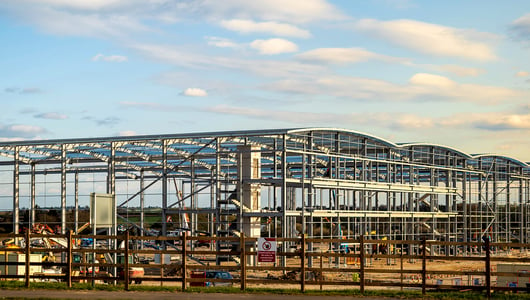Industrial market update Q2 2023

Average industrial property yields which softened sharply last year remained largely unchanged in Q1 2023, as the market absorbed the new economic landscape in the UK.
Even with the repricing of the last year, yields are now around the same level as they were at the start of the pandemic. In the 12 months to the end of March, average capital values for industrial were down 24%, according to MSCI data.

Even so, rents continue to rise, with an average increase of 8.6% in the 12 months to the end of Q1. Some regional markets are registering double digit rental growth, including Tees Valley and Durham, at 13.3% growth, and Manchester with a 12% average rise across light industrial and logistics.
The rise in rents can partly be attributed to continued tight supply in the market with vacancy rates broadly unchanged over the last year – averaging 3.6% for the UK. Constructions levels have risen, and although take-up has slowed, particularly due to more limited requirements for large e-commerce companies such as Amazon, it is still in line with longer-term trends, resulting in positive net absorption in Q1.
There has been a significant rise in the number of schemes under construction in the last few years and a record 78.5 million square feet is currently in the pipeline – with around a quarter being speculative. As these schemes are released the vacancy rate may start to rise, which would put some pressure on rental growth – although it will likely continue to be positive, albeit at a lower rate than current levels. Buildings that are built to a high specification, and especially those that meet the top ESG requirements will still attract a premium. Higher rateable values and higher energy costs will also have an impact on rental growth.
In London, market conditions have been weaker, with lower demand levels pushing vacancy rates to a 5-year high of 4.6%, and putting some downward pressure on rental growth in the capital. The pressure on demand came as retailers moved their distribution centres from outer London to other regional hubs, such as Milton Keynes. However, increased appetite for last-mile delivery units could be behind another rise in demand in the capital if online retailers increasingly focus on the speed of deliveries.

Investment activity remained muted in Q1 after a very slow market in H2 2022 amid the political volatility and economic uncertainty. However, even with such a pronounced drop in activity in H2, the total levels of investment for the final six months of the year were broadly in line with longer-term trends, a reflection of the strength of the industrial sector over the last few years. There are signs that activity will start to rise, with large deals in the pipeline. The re-pricing is engendering increased interest in assets, with some examining whether the downwards movement was too extreme for current market conditions.

As such there may be some evidence in the coming months of prices hardening, which would, in turn, create further activity as those in ‘wait-and-see’ mode start to re-enter the fray.
| **Industrial Q1 2023 unless otherwise stated | **UK | **London & South East |
| **Distribution, multi-let estates and specialised industrial | **Current quarter (last quarter / 5yr ave) | **Current quarter (last quarter / 5yr ave) |
| Occupier | ||
| Availability rate (%) | 5.2% (5.2% / 5.6%) | 6.06% (6.2%/5.5%) |
| Vacancy rate % | 3.6% (3.4% / 3.2%) | 3.9% (3.7%/3.1%) |
| Rental growth (12-month growth rate) | 8.6% (8.9% / 6.3%) | 9.3% (9.9% / 6.6%) |
| Quarterly take up (sq ft) | 13.3m sq ft (16.1m / 24.6m) | 2.7m sq ft (3.2m / 5.7m) |
| Supply | ||
| Completions (net delivered sqft) | 11.5m sq ft (11.2m / 11m) | 2.1m sq ft (1.7m /2.2m) |
| Total under construction (sqft) | 75.0m sq ft (67.1m / 53m) | 17.4m sq ft (15.1m /9.7m) |
| Investment | ||
| Quarterly sales volume £m | £1,597m (£1,960m / £2,833m) | £594m (£712m/ £1,050m) |
| Average yield | 4.7% (4.5% / 4.3%) | 4.3% (4.2% / 3.9%) * |
| Prime yield (rack rented) May 2023 (Q4 2022) | 5%- 5.25% (4.75%-5%) Prime regional | 4.5%-4.75% (4.25-4.50%) Within M25 |
Industrial: key investment transactions
| **Property Address | **Town /City | **Date | **Building size (sq ft) | **Sale Price (£m) | **Net Initial Yield | **Buyer |
| Perimeter Road | Liverpool | Q1 2023 | 585,200 | £57.2m | 4.6% | Brookfield |
| Pilot Way | Coventry | Q1 2023 | 881,000 | £130m | – | Goldman Sachs |
| Lamplight Way | Manchester | Q1 2023 | 53,756 | £6.6m | 4.7% | Cabot Properties |
| Dorando Way | Birmingham | Q1 2023 | 152,000 | £18.1m | 5.1% | Blackstone |
The information provided in this report is the sole property of Cluttons LLP and provides basic information and not legal advice. It must not be copied, reproduced or transmitted in any form or by any means, either in whole or in part, without the prior written consent of Cluttons LLP. The information contained in this report has been obtained from sources generally regarded to be reliable. However, no representation is made, or warranty given, in respect of the accuracy of this information. Cluttons LLP does not accept any liability in negligence or otherwise for any loss or damage suffered by any party resulting from reliance on this publication.
Related research

Commercial market update Spring 2024
It’s now widely accepted that interest rates have peaked, the key question now is when will the central bank start to cut rates, and how low will they go in the coming year.
Office market update Spring 2024
The structural change in the office market is ongoing, with strong appetite for best-in-class office space which meets high net-zero requirements and insipid demand for secondary or tertiary space. The investment market was quiet overall in 2023, although some notable deals were struck where pricing was competitive.
Retail market update Spring 2024
Take-up rose towards the end of 2023, but overall vacancy rates are flattered by the lack of supply in the market. The bright spot for landlords is luxury retail and retail parks, where consumer demand is still relatively stronger.
Industrial market update Spring 2024
Vacancy rates creep up and rents ease. The recalibration of the Industrial market after the pandemic uplift continues, but overall, the sector continues to outperform compared to other asset classes.
Economic update Spring 2024
The economy grew more than expected in November, according to the latest data from the ONS, but there is still a risk that the UK could dip into recession.
Commercial market update Winter 2023
The Bank of England’s decision to keep the base rate on hold at 5.25% for the second consecutive time in November has raised the prospect that interest rates are at their peak.
Office market update Winter 2023
Flight to quality continues. There has never been such a distinct divergence between prime and secondary property, and this is still being driven by companies adjusting to changing working patterns as well as a desire to meet higher net-zero targets.
Industrial market update Winter 2023
Slowing rental growth. Robust occupational market conditions amid tight supply are helping to maintain a continued confidence after significant repricing in the sector.
Retail market update Winter 2023
Slowing market. Prime high street assets are among the best performing within retail – these assets have stabilised and there is opportunity for future rental growth where values have been rebased.
Commercial market update Autumn 2023
Will they? Won’t they? This is the key question around whether the UK’s base rate will exceed 5.75%. There have been enough mixed messages to muddy the waters – inflation data released in June showed that inflation was stuck at 8.7% in May, which prompted forecasts that the base rate would peak at 6.5% from the current rate of 5.25%.
Office market update Autumn 2023
UK office vacancy rate continues to climb. Weak demand and strong supply are resulting in an ever-rising vacancy rate for offices across the UK, which has hit 7.7%, up from less than 5% before the pandemic.
Retail market update Autumn 2023
The retail environment remains challenging. The rising cost of living, and recent disappointing weather have led to a further tick down in overall sales.
Industrial market update Autumn 2023
Vacancy rate remains low. Net absorption of industrial space dipped into negative territory in Q2 2023 for the first time in 11 years as take up fell back to levels last seen before the pandemic.
UK economic update Autumn 2023
The key economic move over the last few months was the Bank of England’s decision not to raise interest rates in September.
UK economic outlook Q3 2023
The economy settled down relatively quickly from the shock of the mini-budget in September last year and the resulting spike in gilt rates and mortgage rates.
Commercial market update Q2 2023
The UK’s economic mood music has been more upbeat so far this year than many would have anticipated in the wake of the mini-budget last year. This culminated in the IMF, traditionally circumspect about the UK’s economic outlook, confirming in late May that the country would not enter recession this year, contrary to its earlier forecasts.
Office market update Q2 2023
Office take-up gained some momentum towards the end of Q1 as employees continue to return to the workplace in greater numbers. But overall demand for office space remains muted compared to historical norms.
Retail market update Q2 2023
Retail sales fell back in May after rising slightly in April, according to a survey from the CBI, but the overall outlook is slightly more upbeat than at the beginning of the year as consumer confidence continues to climb and the prospect of lower energy bills is factored in.
UK economic outlook Q2 2023
Higher than expected inflation dampens expectations for UK economy. Inflation data was higher than expected in May, which has weighed on business confidence, and has pushed interest rate expectations, and the cost of borrowing, higher.
Commercial market update Q1 2023
The bond vs property yield spread ticked up in Q4 but remains nearly the narrowest in a decade.
Retail market update Q1 2023
Retail sales ticked up slightly in January but are still down on a three-monthly basis from the post-pandemic highs in the summer of 2021.
Industrial market update Q1 2023
The strong performance in this sector over the last few years mean that the upheaval caused by rising interest rates and the September’s mini-budget, which caused a surge in gilt yields, was more pronounced than other sectors.
Office market update Q1 2023
UK office vacancy rate rises, but masks a two-tier market.
UK economic outlook Q1 2023
The economic outlook for the UK is challenging this year, but there is growing consensus that the downturn will not be as long as previously expected.
Commercial market update Q3 2022
Bond yields have settled down, but property yields are exposed to some repricing as investors take into account higher borrowing costs.
Industrial market update Q3 2022
Rents and capital values surged this year in response to high levels of demand for occupiers and investors alike.
Office market update Q3 2022
The central theme in this sector is the flight to quality by investors and occupiers alike.
Retail market update Q3 2022
This sector was hit hardest by Covid and the cost-of-living led recession will likely deliver another blow.
Commercial market update Q2 2022
Economy is slowing and, early suggestions that we may avoid recession have been swept aside by the Bank of England following on from their August meeting.
Industrial market update Q1 2022
The rent rise continues: If the classical economists’ definition of inflation being ‘too much money chasing too few goods’ needed a perfect illustration that the industrial sector is it.
Office market update Q1 2022
Historically there has been a very strong link between employment growth and increased demand for office space. The employment market is one part of the economy that is weathering the current storm well.
Retail market update Q1 2022
with so many bad news headlines over the cost-of-living crisis and geopolitical uncertainty, it is no surprise that consumer confidence has faltered and dramatically so.
Commercial market update Q1 2022
The commercial real estate sector has been through an extraordinary year, outperforming other asset classes with total returns of 23.9% over the past 12 months.
Commercial market update Q4 2021
It has been a long pandemic, and Omicron provided a sharp reminder that it might not be over quite yet. Despite this, there are signs of recovery in all sectors.
Industrial market update Q4 2021
Rental growth continues to rise, hitting 7.2% a year in Q4 2021. Industrial space under construction is at the highest level ever recorded.
Office market update Q4 2021
Large year-end London office deals show confidence in the outlook, but TfL passenger volumes took another hit from Omicron in December.
Retail market update Q4 2021
Slide in retail rents halts, but inflation and interest rates pose a threat as cost-of-living bites.
Retail market report Q3 2021
Retail capital values over the last three months have grown by 3.2% (the strongest quarterly rate since 2010) with values stabilising across all retail segments.
Office market report Q3 2021
There are emerging signs of polarisation in the office market between top spec buildings versus those of a lower quality.
Industrial market report Q3 2021
Industrial investment flows are now not only ahead of the same period in 2020 but also significantly ahead of 2019 levels, driven by the continued strength of investor interest in the logistics sector.
Retail market report Q2 2021
Retail yields have repriced as average UK retail yields are now 6.8% which compares with 5.3% five years ago.
Office market report Q2 2021
Financial service companies are seeking out the best model for hybrid working, with 79% of financial service firms surveyed by CBI/PWC in Q2 2021 reassessing their workspace needs and 82% are planning on implanting hybrid ways of working.
Industrial market report Q2 2021
Investment volumes in the industrial sector over last 12 months increase by 75% as investment levels in the sector have soared.
UK retail market review Q4 2020
Internet sales are 56% higher than they were in February 2020. Non-food store sales are 27% lower than at the start of the pandemic however, despite this, traditional retailers are continuing to grow their online presence and shrink their bricks and mortar portfolios.
UK office market review Q4 2020
UK office market more resilient than expected with declines in values less severe than commentators had predicted.
UK industrial market review Q4 2020
Demand for industrial and warehouse space is driven by the economic performance of the retail, logistics and manufacturing sectors.
UK retail market review Q3 2020
2020 has been a difficult year for bricks and mortar retail. It is a commonly repeated aphorism but nonetheless true that the pandemic together with Lockdown 1.0 and 2.0 have crammed five or more years of anticipated changes in markets into the last nine months.
UK industrial market review Q3 2020
The drivers of demand for industrial real estate will continue to evolve.
UK office market review Q3 2020
Structural changes effecting the UK office market will play out over several years.
UK office leasing review Q2 2020
Coronavirus leads to dramatic declines in leasing activity.
UK office investment review Q2 2020
Transaction volumes decline during lockdown.
UK retail leasing review Q2 2020
Landlords and tenants shared the strain of pandemic lockdown. COVID-19 is accelerating the trend in the shake-out of retail.
UK industrial & distribution review Q2 2020
Transaction volumes declined during lockdown, with investment into distribution most favoured.
UK retail investment review Q2 2020
Retail investment market shuts down during the COVID-19 lockdown.
London office market outlook summer 2018
Cluttons has released its London Office Market Outlook report for Summer 2018.

